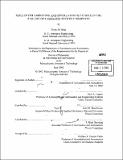| dc.contributor.advisor | Paul A. Lagace. | en_US |
| dc.contributor.author | Shim, Dong Jin, 1972- | en_US |
| dc.contributor.other | Massachusetts Institute of Technology. Dept. of Aeronautics and Astronautics. | en_US |
| dc.date.accessioned | 2005-10-14T19:24:51Z | |
| dc.date.available | 2005-10-14T19:24:51Z | |
| dc.date.copyright | 2002 | en_US |
| dc.date.issued | 2002 | en_US |
| dc.identifier.uri | http://hdl.handle.net/1721.1/29245 | |
| dc.description | Thesis (Ph. D.)--Massachusetts Institute of Technology, Dept. of Aeronautics and Astronautics, 2002. | en_US |
| dc.description | Includes bibliographical references (p. [407]-412). | en_US |
| dc.description.abstract | Analytical and experimental investigations were conducted on laminates with ply dropoffs to better understand the interlaminar stress field and delamination/damage characteristics in such laminates, as well as the relationship between the two based on the strength of materials approach. To gain key insights into the mechanisms and structural parameters that cause interlaminar stresses, analytical models for laminates with simple ply dropoff configurations were developed based on a systematic and hierarchical approach. Mathematically, these individual models are formulated using the stress function method in which the form of the admissible stress field is assumed a priori based on the stress field from the classical laminated plate theory and other functional constraints of the problem. The results are validated via comparisons with numerical solutions from previous investigations and as performed in the current work. Various structural parameters such as the taper angle and the location of the terminated plies are found to affect the interlaminar stress distribution. Careful consideration of the characteristics and trends of the interlaminar stresses in such laminates reveals that two fundamental mechanisms give rise to interlaminar stresses: the termination effect, that is caused by the load transfer from the terminated ply group to the continuous plies; and the offset effect, that is caused by the redistribution of the load from the undropped region to the dropped region in the outer continuous plies through an offset in the through-thickness direction. These mechanisms, the factors that affect them, and their utility are described and discussed in detail. | en_US |
| dc.description.abstract | (cont.) Factors of particular importance are the magnitudes of the far-field loads in the terminated and the outer continuous ply groups, the offset distance, and the taper angle. Experiments are conducted on unidirectional laminate configurations under static and cyclic loads to establish delamination/damage trends when the number and location of the terminated plies are varied. Under both loading conditions, delamination is found to be the dominant damage mode, although other modes, e.g., ply splits, occur. In certain types of specimens under cyclic loading, delaminations in different regions have different growth characteristics causing delaminations in one region to be a greater concern than in another region because the length of the delaminations increases indefinitely. In general, the experimental observations regarding delamination/damage are consistent with expectations based on the stress analysis. Delaminations are generally observed along interfaces where the interlaminar stresses are greatest, and static delamination loads are higher in laminates with lower interlaminar stresses. Quantitative predictions of the delamination loads using the Quadratic Delamination Criterion with the average stress method do not agree as well with the experimental data because a single value for the averaging length could not be obtained. The possible causes for the apparent non-uniqueness of the averaging length and its implications are further discussed. Based on this investigation, further recommendations for work on laminates with ply dropoffs are proposed. | en_US |
| dc.description.statementofresponsibility | by Dong Jin Shim. | en_US |
| dc.format.extent | 488 p. | en_US |
| dc.format.extent | 21001457 bytes | |
| dc.format.extent | 21001258 bytes | |
| dc.format.mimetype | application/pdf | |
| dc.format.mimetype | application/pdf | |
| dc.language.iso | eng | en_US |
| dc.publisher | Massachusetts Institute of Technology | en_US |
| dc.rights | M.I.T. theses are protected by copyright. They may be viewed from this source for any purpose, but reproduction or distribution in any format is prohibited without written permission. See provided URL for inquiries about permission. | en_US |
| dc.rights.uri | http://dspace.mit.edu/handle/1721.1/7582 | |
| dc.subject | Aeronautics and Astronautics. | en_US |
| dc.title | Role of delamination and interlaminar fatigue in the failure of laminates with ply dropoffs | en_US |
| dc.type | Thesis | en_US |
| dc.description.degree | Ph.D. | en_US |
| dc.contributor.department | Massachusetts Institute of Technology. Department of Aeronautics and Astronautics | |
| dc.identifier.oclc | 51686730 | en_US |
